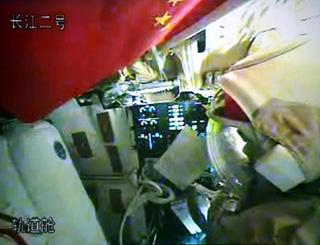China
Taikonauts brace for spacewalk after first day in orbit
Source: xinhua | 09-27-2008 09:05
Special Report: Shenzhou-7 Manned Space FlightBEIJING, Sept. 26 (Xinhua) -- China's third manned space mission Shenzhou-7 on Friday entered a stable circular orbit where the taikonauts assembled the 4.4-million-dollar space suit for extra-vehicular activity (EVA) and trained themselves for the country's maiden spacewalk after spending their first day in space.
 |
| Chinese taikonauts Zhai Zhigang and Liu Boming try their space suits in the orbit module of the Shenzhou-7 spacecraft, in this video grab taken on Sept. 26, 2008. The Shenzhou-7 spacecraft, which blasted off at 9:10 p.m. Thursday at the Jiuquan Satellite Launch Center in northwest China's Gansu Province, has functioned well as planned. (Xinhua/Zha Chunming) |
The spacecraft is circling at 343 km above the earth, orbiting every 90 minutes. It blasted off in northwest China at 9:10 p.m. on Thursday.
Starting from 10:20 a.m. Friday, two taikonauts Zhai Zhigang and Liu Boming spent more than 11 hours unpacking and assembling the EVA suits in the orbital module, while Jing Haipeng stayed in the re-entry module to keep an eye on the vessel operation.
One of the suits is China-made Feitian while the other is a Russian Orlan.
Tests by the two astronauts showed the two suits were normal, according to the ground command in Beijing. The two men were also in normal physical condition, the ground command said.
Zhai and Liu began adaptive training after finishing assembling the suits. The training, which was to make sure the taikonauts could adapt to the low-gravity environment in space, lasted about 100 minutes.
The spacewalk, expected to last about 30 minutes, is scheduled to take place at 4:30 p.m. Saturday.
One taikonaut will conduct the spacewalk assisted by another who will stay in the orbital module during the process. The other one will stay in the re-entry module.
The spacewalker will fetch a piece of experimental material fixed on the exterior surface of the orbital module.
The exact duration of the spacewalk, however, might be adjusted according to the physical condition of the taikonaut, according to Wang Zhaoyao, spokesperson with the manned space program.
Wang said the whole process would be broadcast live on television.
"EVA is a big leap for the manned space program," he said. China had made a series of technical breakthroughs, including the research and development of an EVA suit and an airlock module.
The process of extravehicular activities cannot be simulated completely on the ground and some of the newly developed products are to be tested in flight for the first time. Thus, The capability and skills of the taikonauts and the quality of their operations would directly determine the result of the mission, he said.
Yang Liwei, who piloted China's maiden space flight in 2003, has said the intensive psychological shock would be unavoidable for the astronaut when he moved out of the capsule.
Since the operation was highly automatic, it was the psychological factor other than the manual operation that decided the success of the mission, Yang said.
If Shenzhou-7 mission is successful, China will become the third country after the former Soviet Union and the United States to accomplish a spacewalk, a crucial capacity if China is to have its own permanent space station.
A GIANT LEAP
"China's space program has witnessed a giant leap forward in the past 16 years," Chinese President Hu Jintao said when he met scientists and technicians at the Jiuquan Satellite Launch Center and encouraged them to continue the efforts for a "complete success" of the Shenzhou-7 mission on Friday morning.
Hu, who saw off the three taikonauts on Thursday, said he felt "very happy" while witnessing the liftoff of Shenzhou-7 at the launch center.
"The efforts made by generations of scientists, cardres, workers, army officers and soldiers for the space program will never be forgotten," Hu said.
Hu said China still faced arduous tasks in the manned space program and he expressed his hope that Chinese scientists and researchers would "make persistent efforts and constantly strive to become stronger" so as to make further contributions in the manned space program.
Also on Friday, the chief designer of the spacecraft system Zhang Bainan said China would begin the mass production of its Shenzhou spacecraft starting from the Shenzhou-8 mission.
Zhang said the mass-produced model would serve as a shuttle between China's space station and the ground, and may also transport astronauts and cargo for other countries.
He revealed that the finalized model, highly home-made, should be safer, more reliable and able to support three astronauts to fly for seven days and complete the task of space station docking. "The mass production would also allow intensive launch in a short period of time," he said.
Apart from finalizing the model of China's manned spaceship, another mission of the Shenzhou-8 was to seek for a breakthrough in the orbiter docking technology, a must step for the ultimate goal of building a permanent space laboratory and a space engineering system that allow astronauts to conduct scientific experiments of larger scale.
| Comment
|
Interactive: Be part of China's journey to space!
Editor:Liu Fang



